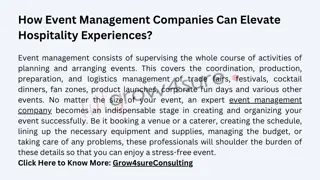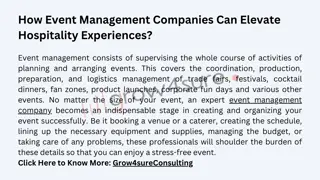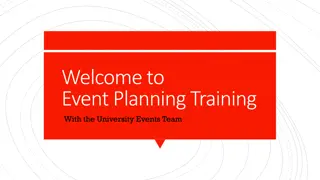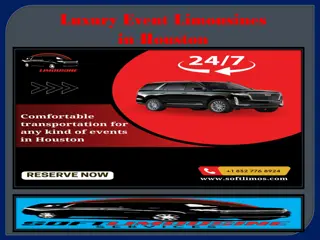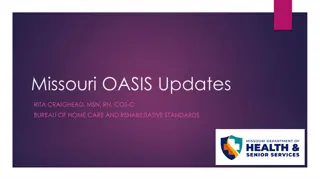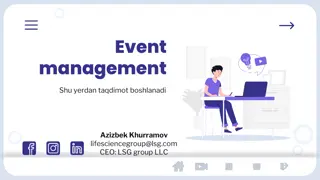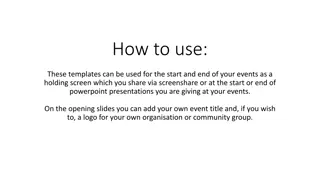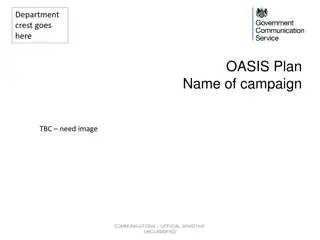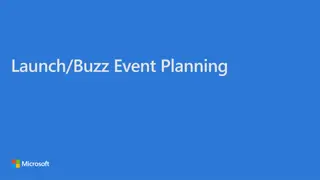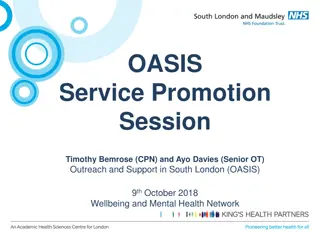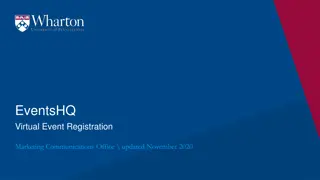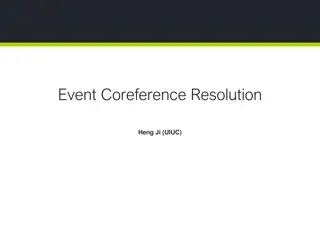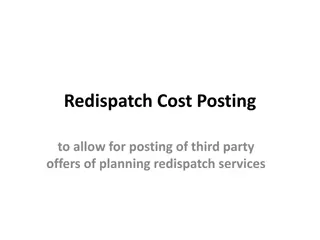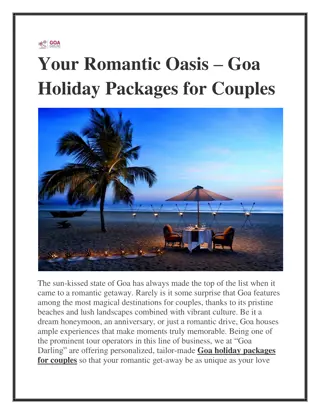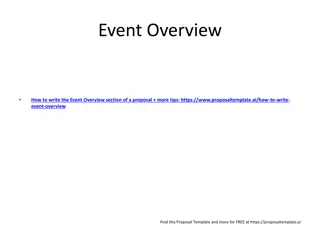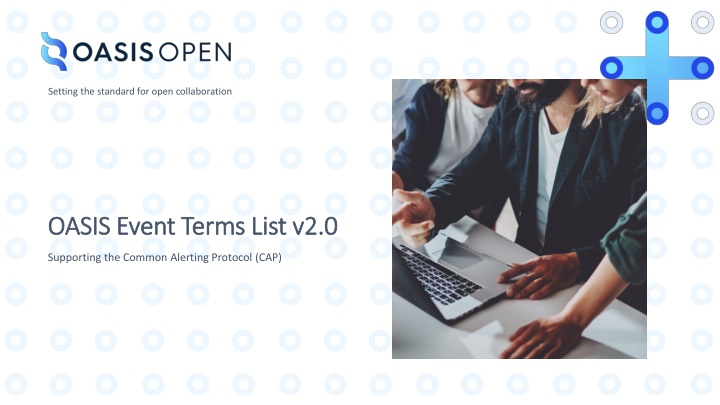
Advancing Interoperability with OASIS Event Terms: User Guide Announcement
The OASIS Emergency Management Technical committee has announced the development of an OASIS Event Terms User's Guide to complement the existing OASIS Event Terms List. This user guide aims to offer guidance on utilizing the listed terms in CAP messages, enhancing interoperability among practitioners by explaining how to select appropriate codes and process them effectively.
Download Presentation

Please find below an Image/Link to download the presentation.
The content on the website is provided AS IS for your information and personal use only. It may not be sold, licensed, or shared on other websites without obtaining consent from the author. If you encounter any issues during the download, it is possible that the publisher has removed the file from their server.
You are allowed to download the files provided on this website for personal or commercial use, subject to the condition that they are used lawfully. All files are the property of their respective owners.
The content on the website is provided AS IS for your information and personal use only. It may not be sold, licensed, or shared on other websites without obtaining consent from the author.
E N D
Presentation Transcript
Setting the standard for open collaboration OASIS Event Terms List v2.0 OASIS Event Terms List v2.0 Supporting the Common Alerting Protocol (CAP)
Topic for Today Event Terms - OASIS Guidance on Event information (terms and codes) to advance interoperability in CAP messages - https://docs.oasis-open.org/emergency/etl/v1.0/etl-v1.0.pdf - Event: is something that happens (in time and space), a happening with a beginning and end - Alert-able Event: a significant event worthy of being alerted
Agenda Content Documents Event Views Existing Guidance Material Event Terms Supporting Material Three New Documents Quick review - Business of Alerting Versioning Additional Topics Multi-Instancing 3
TS/Hurricane Example Avalanche Example Event View (the Event large area, long time) Event View (the Event small area, short time) Day 1 to Day 14 Day X Alerting View (the Concern small area, shorter time) Alerting View (the Concern larger area, longer time) Day 6 to Day 12 Day 1 to Day N CAP View (the Subject Event small area, shortest time) CAP View (the Subject Event larger area, no end time) Day 9 to Day 12 Front loaded to Day 1 but open ended
- In 2021, the OASIS Emergency Management Technical Committee developed and published an evergreen Reference Document, the OASIS Event Terms List, as Supporting Material for use with CAP Event Terms - The document lists terms that can be used to name many of the alert-able events that occur around the world - However, the document did not explain with enough detail the interoperable practices and strategies such a list offers
- Today, the OASIS Emergency Management Technical committee is announcing the development of an OASIS Event Terms User s Guide to go with the OASIS Event Terms List reference document as Guidance Material for CAP Practitioners User s Guide - The guide will address the list of terms and how to use them as the type of Event, Concern, and in CAP messages the Subject Event - The guide will also address how CAP originators can select the appropriate codes from the list - Also provide guidance to CAP consumers on how to process them - All with the aim of enhancing interoperability between parties
Business Side of Alerting Path of Distribution Implementation Side of Alerting Alerting Agency (Alert Originator) Audience (Alert Consumers) CAP Originating Agent CAP Consuming Agent
The CAP Standard An information model for businesses (agencies) in the field of alerting to exchange ideas about alert-able events of interest 01 A data format for implementers (engineers) in the field of alerting to exchange data about alert-able events of interest 02 A standard to promote interoperability between all alerting practitioners (businesses and implementers) 03 CAP is flexible, maybe too flexible! 3a A standard that clearly requires Guidance and Supporting Material for all alerting practitioners to access and use 04 Material is sparse, maybe too sparse! 4a
Business View of Alerting Alert Originating Agency Alert Consuming Audience Terms Codes Path of Distribution Implementation View of Alerting CAP Originating Agent CAP Consuming Agent
- Aside from the Events, Alerts, and Subject Events discussions, the OASIS Event Terms User s Guide has sections that provides guidance on many other event-based topics - Multi-Event situations several events grouped together - Open ended situations events with no known start and/or end time - Call to Action situations events like boil water, evacuate, etc - Emergency situations events, usually several, that group together and classify as an emergency - Non-public situations events that are not alert-able for the general public, or events that are, but are distributed privately through a commercial service, etc - Naming alerts alerts with names derived from the event, i.e. tornado warning where tornado is an event based descriptor in the alert name - Non CAP based alerts events typically handled without CAP, i.e. road signs, trail signs, announcements over speakers, etc - Standard CAP Categories used for filtering, routing and presentation purposes - New Terms submitting terms, publishing table updates, keeping current without keeping current - Numerous Examples Topics
Agenda Content Documents Existing Guidance Material Event Views Three New Documents Quick review - Business of Alerting Versioning Event Terms Supporting Material Multi-Instancing Additional Topics 11
- Currently the OASIS Event Terms List is covered in one document. - It is an OASIS Committee Note Document Management - Going forward there are plans for three separate documents - A Committee Note Lookup Table of terms and codes - A Committee Note Terms Discussion without the Table - A Committee Note User sGuide, referencing them both - Overall, the three documents will make the material easier to use - Versioning - - - Each to be independently Versioned Each will have a Public Review Stage Reviewers welcome (contact Norm Paulsen normpaulsen.fi@gmail.com and Thomas Wood thomas.wood@drcf.net )
- OASIS highly recommends that CAP practitioners in the global alerting community, take up and use the OASIS Event Terms List and include at least the codes from the list in CAP messages to advance interoperability Uptake - Even if originators have no use for the material, it will help consumers process the CAP alert messages and generally improve their ability to filter, route, and finally present the message content to audiences
- CAP has a simple multi-instance design for several of its elements in the CAP schema - <eventCode>, <geocode>, <parameter> - These are all user defined elements with versioning accounted for in the XML design Multi-Instance Design - At the technical level, it is an easy addition to a CAP message. - The User s Guide goes into detail on how to do just that
Tornado Example <eventCode> <valueName>OET:v1.x</valueName> <value>OET-199</value> </eventCode> <eventCode> <valueName>OET:v2.x</valueName> * <value>OET-LT-###</value> </eventCode> <eventCode> <valueName>SAME</valueName> <value>TOR</value> </eventCode> Name and Format for v2.x TBD (to be finalized) *
With a multi-instance strategy Multi-Instance Value - Version 1 does not have to be removed to make way for Version 2 they can coexist Originators can add Version 2 to their CAP offerings knowing it will help Consumers without having to remove Version 1 Version 1 can remain in an originating CAP service as long as there are users for Version 1 Originators and consumers do not have to align implementation dates, as long as the originator has added one or the other or both, Consumers can choose to use one or other or both Version 1 list will be frozen and it will be version 2 that will be updated going forward - - - -
Agenda Content Documents Event Views Existing Guidance Material Quick review - Business of Alerting Three New Documents Event Terms Supporting Material Versioning Additional Topics Multi-Instancing Thank You Norm Paulsen (normpaulsen.fi@gmail.com) 17



